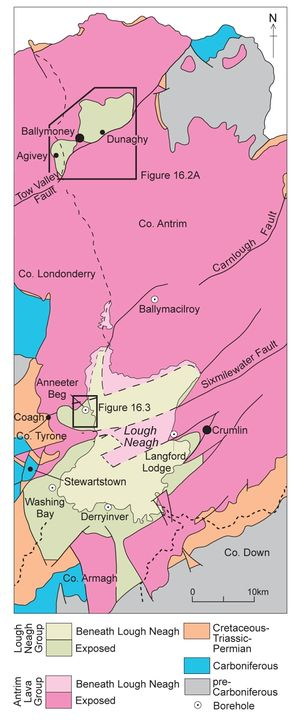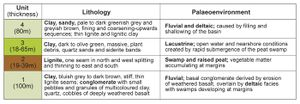Lough Neagh Group, Late Palaeogene (Oligocene), Northern Ireland
| Mitchell, W I (ed.). 2004. The geology of Northern Ireland-our natural foundation. Geological Survey of Northern Ireland, Belfast. |
W I Mitchell
Lough Neagh Group




Exposures of the Lough Neagh Group are not known in either of the main areas of outcrop around Lough Neagh or at Ballymoney (P947874). Nevertheless, detailed information on its stratigraphy and subsurface outcrop is available from the results of an extensive drilling programme that confirmed the presence of lignite seams and provided information on the lithostratigraphy, biostratigraphy, mineral composition and sediment provenance [1]. The Lough Neagh Group comprises the Dunaghy and Ballymoney formations (P947947).
Dunaghy Formation
The subsurface outcrop of sedimentary rocks of the Dunaghy Formation is confined to the Ballymoney and Agivey ‘basins’ (P947874). At Ballymoney, the rocks occupy three separate areas in the hanging wall of the Tow Valley Fault ( (P947875)A) and range in thickness from 22 m to a maximum of 276 m in the Dunaghy borehole [C 980 264]. In the Agivey ‘basin’, the formation comprises 66 m of multicoloured clay and gritty clay, thin lignite beds and thin conglomerates. The prevalence of shearing in these rocks, and of faulted contacts at the top and base, is a reflection of more than 400 m of post-Oligocene dip-slip on the Tow Valley Fault.
Basalt lava underlying the Lough Neagh Group at Ballymoney is weathered to a depth of up to 80 m and is altered to a mixture of yellowish brown, reddish brown and purplish red, clay-rich lithomarge. Relict igneous textures include net veining, incipient brecciation, the outline of former zeolite-filled vesicles and spheroidal weathering. Clasts in 6 m of yellow, pink, grey and brown conglomerate and breccio-conglomerate at the base of the Dunaghy Formation consist of decomposed basalt derived from the weathering profile in the underlying lavas. Higher strata consist mainly of reddish brown lateritic clay, mottled in shades of brown, blue, grey, purple and green. Thin sections of bluish grey mudstone include beds and small nodules of authigenic siderite, sandy clay, coarse-grained sand and rare beds of brown lignitic clay and black lignite from 0.5–5 m thick.
Organic residues are dominated by wood fragments and plant tissue but also contain sparse palynomorph assemblages of bisaccate pollen Erecipites spp., Laevigatosporites spp. and Nyssapollenites satzveyensis that are typical of the Late Oligocene of the British Isles [2] and of the SP8 zone [3]. In particular, Corsinipollenites oculusnoctis and Tricolpopollenites spinus are confined to the Late Oligocene of western Britain. The flora in the Dunaghy Formation indicates a cool temperate, peat-forming, freshwater swamp environment dominated by ferns and mosses with a densely vegetated hinterland. Nearby upland/montane forests largely consisted of conifers.
Ballymoney Formation
This formation is restricted to the Ballymoney and Agivey areas, north of the Tow Valley Fault, and to the shores of Lough Neagh (P947874). It usually rests unconformably on the Antrim Lava Group, except where the Dunaghy Formation intervenes, and in the area southwest and south of Lough Neagh, where it oversteps onto Triassic and Lower Palaeozoic rocks. Multiple seams of lignite occur in the concealed basins at Ballymoney and near Coagh [1]
In the Ballymoney area, the Lough Neagh Group is concealed by up to 70m of glacial till [4]. The Ballymoney Formation has a composite thickness of about 240 m, but does not exceed 200 m in any borehole. Within the succession are six lignite seam groups with a maximum total thickness of 177 m. Near Ballymoney, lignite is concentrated in one seam which is 105 m thick (Figure 16.2, Borehole 1); it comprises a bed 100 m thick (Seam Groups B, C, D) and 5 m of clay. Northeast of Ballymoney, the 100 m bed of lignite is now represented by 120 m of strata, but seam splitting has reduced the composite thickness of lignite to 38 m ((P947874), Borehole 2). Further to the east, this trend is reversed and seam thickening and merging results in an aggregate thickness of 70 m with one lignite bed over 50 m thick (Figure 16.2, Borehole 3).
Near Coagh, in east Co. Tyrone (P947874), the outcrop of the Lough Neagh Group is concealed by up to 36 m of glacial deposits [1]. The margins are unfaulted and the strata dip gently towards Lough Neagh. The Ballymoney Formation has a maximum thickness of 282 m (base of formation not penetrated) in the borehole at Anneeter Beg.
The lignite consists of massive brownish black, woody and non-woody material grading into lignitic clay. Leaf and plant debris is rare but well-preserved specimens are common in the lignitic clay, with roots and stems in growth position. Grey and brownish grey, very stiff clay consisting mainly of kaolinite, sandy clay and thin clayey sand separate the lignite seams. Sedimentary structures such as laminations or bedding are rare. Grains of authigenic siderite are common in the clay, with beds of hard, grey to yellowish grey sideritic ironstone up to 0.3 m thick. The Coagh area is the only part of the outcrop of the Ballymoney Formation in which lithological units, other than lignite, can be correlated between boreholes (P947876). Distinctive clays of Unit 3 (P947948) are also underlain by lignite in the boreholes at Derryinver and Washing Bay (P947874) and are referred to the "Middle Shales" [5].
Pollen assemblages confirm the Late Oligocene (Chattian) age of the Ballymoney Formation[2]. Particularly important is Cicatricosisporites chattensis, which is restricted to the Chattian Stage, Boehlensipollis, which in France is restricted to the Oligocene and an association of the long-ranging forms Arecipites, Dicolpopollis and Monocolpopollenites, which are most common in the Oligocene. The assemblages indicate a warm temperate, frost-free climate and swamp environment with coniferous pollen derived from upland regions. Unit 3 contains the bivalve Unio and gastropod Viviparus, with ostracods and diatoms [6].
Sediment provenance in the Lough Neagh Group
Continuous movement on the Tow Valley Fault zone and other northeast-southwest trending fractures sustained basin subsidence in the Late Oligocene during deposition of both the Dunaghy and Ballymoney formations. Thus, in the Ballymoney-Agivey area, the margins of the Dunaghy Formation ‘basin’ were overstepped by the Ballymoney Formation in an areally more extensive, successor basin. Provenance studies of heavy minerals in the Lough Neagh Group indicate that the Palaeogene basalt lavas were the dominant source for the detritus, particularly at Ballymoney.[6] However, in contrast at Crumlin, some coarse sediment was derived by erosion of unroofed Palaeogene granites of the Mourne Mountains Complex. At the base of Unit 4 (P947948), in east Co. Tyrone, some detritus originated from the early Ordovician Tyrone Igneous Complex, the Devonian rocks of the Fintona Block and from Triassic rocks. This change was caused either by drainage systems eroding through the basalt into older rocks, or by the headward expansion to the west and northwest of the main drainage arteries.
References
- ↑ 1.0 1.1 1.2 Geological Survey of Northern Ireland 1984. Mineral Exploration Programme, volumes 2, 3, 5, 6, 8.
- ↑ 2.0 2.1 Wilkinson, G C, Bazley, R A B, and Boulter, M C. 1980. The geology and palynology of the Oligocene Lough Neagh Clays, Northern Ireland. Journal of the Geological Society of London 137, 65–75.
- ↑ Meyer, K J. 1988. The description of the interregional zonation of the Palaeogene (SP zones 1–8). Subgroup Palynology (pollen, spores). Geologisches Jahrbuch, 100, 288–94.
- ↑ Geological Survey of Northern Ireland. 1999. Coleraine, Northern Ireland Sheet 13. Solid and Drift Geology. 1:50 000. (Keyworth, Nottingham: British Geological Survey).
- ↑ Fowler, A, and Robbie, J A. 1961. Geology of the country around Dungannon. Memoir of the Geological Survey of Northern Ireland, Sheet 35 (Northern Ireland).
- ↑ 6.0 6.1 Parnell, J, Shukla, B, and Meighan, I G. 1989. The lignite and associated sediments of the Tertiary Lough Neagh Basin. Irish Journal of Earth Sciences, 10, 67–88.